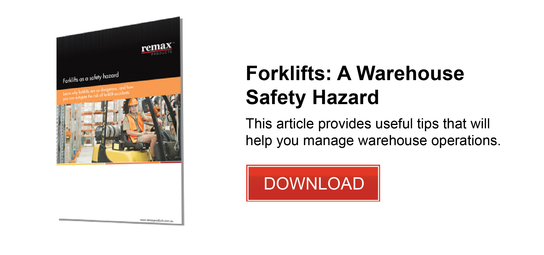5 Checklists to Avoid Forklift-Related Accidents
Forklifts are a major cause of accidents and injuries in many warehouses and workplaces all over Australia. These accidents damage warehouse facilities and pose a health and safety hazard to employees. In the past month alone, there have been several forklift-related accidents, including:
- Last month, MSN News reported the death of a 48-year-old man who was struck by a prong of a pitchfork attachment on another forklift while moving hay bales in Narrogin, Western Australia.
- Earlier this month, The Mercury reported a forklift-related death in Launceston, Tasmania. This time, the casualty was a 24-year-old man who was pinned underneath a forklift after it tipped to its side during the process of unloading.
- Just over a week ago, WA Today reported that a man was injured due to an accident which trapped him between a forklift and a scissor lift in Henderson, Western Australia
Occupational health and safety organisations such as WorkSafe Victoria, Safe Work South Australia, Department of Employment Queensland and WorkSafe Western Australia have taken action and built campaigns aiming to educate warehouse supervisors, managers and forklift operators on the dangers presented by forklifts. An example is the poster created by WorkSafe Victoria for their campaign ‘ Forklifts and people don’t mix’.

(Image source: WorkSafe Victoria)
Aside from this WorkSafe Victoria has developed a handbook titled Forklift safety – Reducing the risks to help warehouse managers mitigate risks of forklift accidents. Workplace Health and Safety Queensland and Safe Work South Australia both have their own versions of this handbook.
These handbooks identify 5 main elements that are crucial for warehouses to implement in order to avoid forklift-related accidents:
1. Employee Training
Forklift operators need to take the necessary safety precautions when operating the vehicle:
- Wear seatbelts
- Obey speed limits and stop signs
- Avoid turning when negotiating grades, ramps or inclines
- Slow down or sound the warning horn when approaching an intersection
- Check all areas the forklift will operate in to ensure there are no hazards (blind spots, spills, dim lighting, obstructions, etc)
- Put procedures in place to ensure an operator can be rescued if an incident occurs
2. Well-Maintained, Safe Machinery
- A well-maintained forklift is crucial to prevent accidents.
- Ensure you purchase forklifts that come with safety measures
- Build a maintenance program that includes a regular schedule of services, preventative maintenance, inspections and cleanings that is performed by a trained employee
- Ensure seatbelts are fitted and that there is a mechanism to prevent the forklift from being started unless the seatbelt is fastened
- For increased safety, equip forklifts with anti-slip surfaces and grab-rails
3. Regular Monitoring and Supervision
Employers have a primary duty to provide a safe workplace, and monitoring is a key part of ensuring safety in the workplace. WorkSafe Victoria recommends that employers mandate the daily check of all forklifts by operators to ensure that everything is functioning well before using any forklift. The checklist involves looking at and / or testing:
- Tires
- Fluids
- Seating
- Warning devices
- Capacity
- Mast
- Forks
- Seatbelt
- Sontrols and fluids
There should also be a procedure for employees to follow in case they come across an unsafe forklift. Aside from this, the warehouse environment should also be monitored.
4. Systematic Traffic Management
Traffic management is a crucial component of warehouse management for reducing the risk of accidents caused by forklifts colliding with pedestrians. Separate paths for pedestrians and forklifts using tape markings or guard rails or create ‘no go’ zones for pedestrians and forklifts where necessary. Detail in a site map all the areas which require certain actions such as
- Traffic flow
- Speed limits
- Parking areas
- Maneuvering and loading areas
- ‘No go’ zones
- Pedestrian crossings
- Required ‘give ways’
Display this site map clearly in the facility.
5. Safe Warehouse Environment
Assess the physical environment:
- Lighting
- Ventilation
- Housekeeping
- Road surfaces
Ensure your warehouse is well-lit to improve visibility, as a dark warehouse is prone to accidents. Make sure roads are well formed and clearly marked, remove blind corners and ensure intersections have proper lighting.
Where necessary, use signs, safety barriers, containment fences, boom gates and even overhead walkways to maintain employee safety. It is recommended to install safety and visibility mirrors in various sections of the warehouse to allow forklift operators to see the movement in the warehouse in front of them or behind them.
Despite all these measures, however, forklift accidents can still happen. It is important to note that such an accident can damage your facilities, equipment and inventory. Mitigate the additional risk of external contamination due to faulty doors caused by forklift accidents with rapid roller doors that are built to adjust during a collision, sustain impact and can be reset easily.
To learn more about avoiding forklift-related accidents, refer to our whitepaper below:





